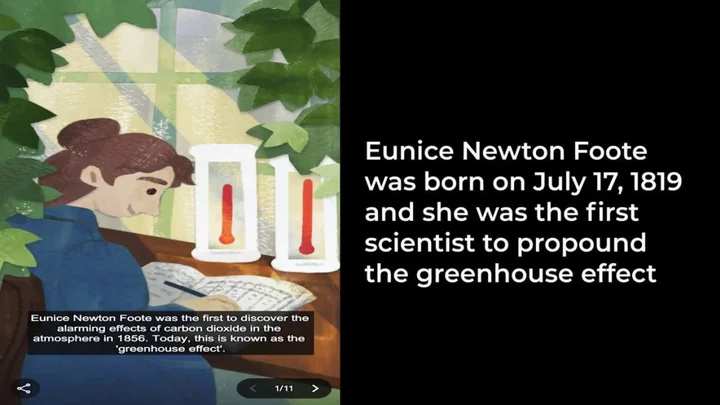
Who is Eunice Newton Foote? The scientist celebrated in today's Google Doodle
We talk about climate change and the devastating effects of greenhouse gases on a daily basis, yet many of us have never heard of Eunice Newton Foote. The American scientist was the first person to realise the alarming impact of carbon dioxide in the atmosphere, all the way back in 1856. So, to mark what would have been her 204th birthday, Google has dedicated today’s Doodle to the environmental pioneer. Head to the search engine and you’ll find an 11-part slideshow explaining Foote’s most significant work. Sign up for our free Indy100 weekly newsletter It goes on to point out that her research was largely ignored for almost 100 years, and credits her with being the first person to “plant a seed of interest in the issue of climate change”. And for anyone wondering, her surname is no coincidence: her father was allegedly a distant relative of Sir Isaac Newton. In a blurb to its Doodle, Google points out that whilst science was Foote’s lifelong passion, she also dedicated time to campaigning for women’s rights. In 1848, she attended the first Woman’s Rights Convention in Seneca Falls, New York State and became the fifth signatory of the Declaration of Sentiments — which demanded equality for women in social and legal status. Back then, women were largely shunned from the scientific community, but this didn’t stop Foote from conducting experiments on her own. After placing mercury thermometers in glass cylinders, she noticed that the cylinder containing carbon dioxide heated up the most and took the longest to cool down. As a result, she became the first scientist to draw a connection between rising CO2 levels and the warming of the atmosphere. After publishing her findings, Foote wrote a second paper on atmospheric static electricity for the journal ‘Proceedings of the American Association for the Advancement of Science’. These were the first two physics studies to be published by a woman in the US, as Google notes. In 1856, a male scientist presented her work at the annual meeting of the American Association for the Advancement of Science. This then lead to further experiments which uncovered what is now known as the Greenhouse effect. And whilst none of us relish the fact this phenomenon exists, we should be eternally grateful to Foote for flagging it to us, all those years ago. Have your say in our news democracy. Click the upvote icon at the top of the page to help raise this article through the indy100 rankings.
2023-07-17 15:48

Scientists say drinking coffee gives ‘special boost’ to the brain
If you’re anything like us, the first coffee of the day is the only thing that can get us up on a morning – and it turns out, there’s real science behind it. Everyone knows that coffee can give us a welcome caffeine hit, but it’s now been revealed that the drink also gives us an extra ‘special boost’ too. Scientists have claimed that the act of drinking a cup of joe gives the body a lift, making us more alert, which can’t be replicated merely with caffeine. In fact, new research shows that drinking hot coffee activates additional areas of the brain. Sign up to our free Indy100 weekly newsletter Scientists from the University of Minho in Portugal and elsewhere looked into the effects of coffee outside of just caffeine content as part of a study – and they found that plain caffeine didn’t have the same impact. In fact, a cup of coffee also influenced working memory and goal-directed behaviour. “There is a common expectation that coffee increases alertness and psychomotor functioning. When you get to understand better the mechanisms underlying a biological phenomenon, you open pathways for exploring the factors that may modulate it and even the potential benefits of that mechanism,” study co-author Nuno Sousa explained. Experts said that drinking coffee actually increased the connectivity in the brain’s more advanced nerve network controlling vision, and other parts involved in working memory, cognitive control and goal-directed behaviour – something not found when participants only took caffeine. Researchers also said that if subjects wanted to not just feel alert but ready to go, caffeine alone might not do the job. “Acute coffee consumption decreased the functional connectivity between brain regions of the default mode network, a network that is associated with self-referential processes when participants are at rest,” study co-author Maria Picó-Pérez said. “The subjects were more ready for action and alert to external stimuli after having coffee,” she added. Have your say in our news democracy. Click the upvote icon at the top of the page to help raise this article through the indy100 rankings.
2023-07-17 00:00
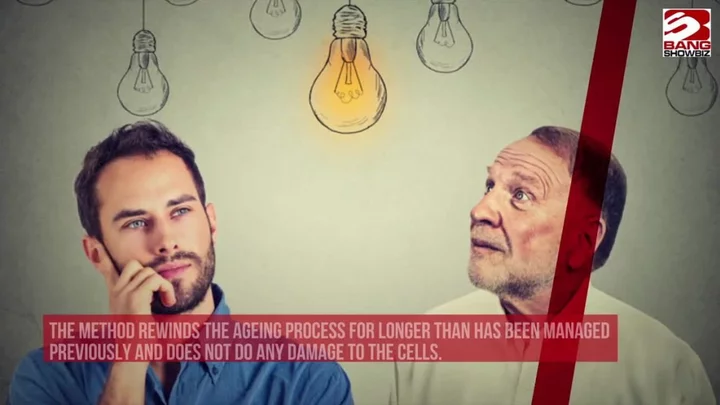
The reason why people really did look older in the past
Back in the day, it’s said that people looked a lot older earlier in life than they do now. As it turns out, there’s a few reasons why. A video essay exploring the phenomenon from Vsauce posits a few explanations why we notice people looking older at a younger age in old footage and photographs. For one, the improvements in standards of living and advancements in healthcare over the years offer an obvious factor. There’s also subconscious bias surrounding fashions from years gone by and their connection with older generations. Sign up to our free Indy100 weekly newsletter However, a study from 2018 also explored how biological ageing has changed in a short space of time. Did People Used To Look Older? www.youtube.com It found that human beings are actually biologically “younger” now than ever when it comes to changes in things like blood pressure – so there’s an actual physical difference between the generations that explains why people looked older sooner back in the day. The study explained that this is down to factors such as a fall in smoking, reading: "Over the past 20 years, the biological age of the U.S. population seems to have decreased for males and females across the age range. "However, the degree of change has not been the same for men and women or by age. Our results showed that young males experienced greater improvements than young females. This finding may explain why early adult mortality has decreased more for males than females, contributing to a narrowing of the gender mortality gap. Additionally, improvements were also larger for older adults than they were for younger adults." Have your say in our news democracy. Click the upvote icon at the top of the page to help raise this article through the indy100 rankings.
2023-07-16 19:57

'Alien' suddenly transforms into a totally different creature in jaw-dropping underwater footage
If ever anyone needs proof that aliens exist, they need only turn to the bottom of the sea. No, we’re not talking about fragments of interstellar meteors or spacecraft, we’re not even talking about mysterious mermaids, we’re talking about the extraordinary creatures that lurk in the depths of our oceans. One of these incredible beasts has been captured on film, swimming more than 3,700ft (1,128m) below the surface of the Indian Ocean. What makes this “alien” so special is not just the fact it’s able to live so far beneath the waves, but the fact it can transform its appearance entirely in just the blink of an eye. Sign up for our free Indy100 weekly newsletter The jaw-dropping metamorphosis was recorded thanks to a remotely operated vehicle (ROV), which was exploring the sea off the East coast of Africa. In the clip, the creature – which looks more like a strange logo than a living being – can be seen floating serenely in the water. Then suddenly, 40 seconds into the video, it seems to shrink into a small black dot. On closer inspection, it’s clear that this isn’t a black dot but a jet-black jelly, decked out with streams of pulsating, technicoloured lights. The video was posted to YouTube by the user CaptainJRD back in 2013. In a caption, he explained that it was taken “at a depth of 3753 ft in the Indian Ocean within close proximity to a drill wellhead. “Near the end of the footage you can see the creature getting caught up in the output from the ROV thrusters. The video has not been altered,” he added. Alien looking creature transforming near Ocean floor at over 3700 feet.Video from ROV www.youtube.com The recording has been watched more than 5.8 million times, with viewers agreeing that it was the most “alien-looking creature” they’d ever seen. “If this isn’t one of the coolest things ever, I’m not sure what is,” one wrote. “Is no one gonna talk about how it looked like a disco ball after it transformed? This is an amazing discovery,” commented another. “This is why I never go more than 1000 ft underwater when I go to the beach,” joked a third. And a fourth added: “I’m a strong believer that everything deep deep down in the ocean looks like an alien. I also bet that there’s a lot of crazy species we’ve never seen before, hell I wouldn’t be that surprised if a 900 million-year-old dinosaur dwells at the bottom of the ocean.” Meanwhile, other commentators were quick to identify the creature, with most agreeing that it was a unique form of comb jelly. “For those wondering, this is a Bloodbelly Comb Jelly also called Lampocteis. Really beautiful creatures,” one wrote. Viewers also shared their dismay at what became of the stunning beast. Watch till the end of the video and you’ll see that no sooner does it execute its glorious transformation than it is brutally torn apart, apparently by a valve on the wellhead. “I became absolutely mesmerized. It was one of the most beautiful creatures I've ever seen, and then it suddenly just got ripped apart,” one commented. Hailing it as a “powerful video” another lamented: “The camera catches the most amazing, beautiful creature never seen before, just to see it torn to shreds by the oil blowout valve. “So very sad and also fitting for what we do to nature every second, everywhere on Earth.” Have your say in our news democracy. Click the upvote icon at the top of the page to help raise this article through the indy100 rankings.
2023-07-16 17:27

How one lake has captured the moment we changed the world forever
The floor of Crawford Lake in Ontario acts like a storybook, preserving Earth’s recent history in chronological order. Crawford Lake reveals the activities of local Iroquoian communities from the late 13th to 15th centuries, all the way through to the present day. This is because Crawford Lake is a meromictic lake, meaning that the dense bottom layer of water does not mix with the less dense upper layers. “The isolated bottom layer of water remains under disturbed, enabling the accumulation of clearly laminated valves which record precise information about the time during which they were deposited,” according to the Anthropocene Working Group. Experts have nominated Crawford Lake as representation for the start of the Anthropocene epoch, a proposed new geological era characterised by significant changes to the planet’s surface as a result of human behaviour. The Anthropocene is yet to be officially accepted as a unit of geologic time, but in 2016 a working group under the guidance of an International Commission on Stratigraphy subcommittee agreed that human behaviour has left scars so deep that they will remain evident even into the distant future. Sign up to our free Indy100 weekly newsletter One of the most notable markers of the Anthropocene is the appearance of plutonium, a radioactive material that appeared in the mid-20th century as a result of hydrogen bomb tests. “The presence of plutonium gives us a stark indicator of when humanity became such a dominant force that it could leave a unique global ‘fingerprint’ on our planet,” explained Professor Andrew Cundy, Chair in Environmental Radiochemistry at the University of Southampton and member of the Anthropocene Working Group. “In nature, plutonium is only present in trace amounts. But in the early-1950s, when the first hydrogen bomb tests took place, we see an unprecedented increase and then spike in the levels of plutonium in core samples from around the world. We then see a decline in plutonium from the mid-1960s onwards when the Nuclear Test-Ban Treaty came into effect.” Agreeing on a simple measure that defines the boundary between chapters in Earth’s history is just the first step. This measure requires agreement among scientists on a single location to define the boundaries. Known as the Global Boundary Stratotype Section and Point, or a golden spike, plays a crucial role in standardising these borders between epochs. The Anthropocene Working Group has been evaluating potential golden spike sites, from Oued Akrech, Morocco, to Alano di Piave, Italy. After spending three years assessing the qualities of a dozen potential golden spikes for the Anthropocene, finally the AGW has landed on Crawford Lake. “Crawford Lake is so special because it allows us to see at annual resolution the changes in Earth history throughout two separate periods of human impact on this small lake,” micropalaeontologist Francine McCarthy of Brock University in Canada, a voting member of the AGW, said at a press briefing. The lake’s unique properties, such as its small size, depth, and lack of water mixing create sediments that precisely record environmental changes over the past millennia. To officially establish the Anthropocene in the International Chronostratigraphic Chart, the golden spike at Crawford Lake must undergo a series of voting by various commissions and unions. If successful, it will mark the moment when human activities permanently altered the planet. Have your say in our news democracy. Click the upvote icon at the top of the page to help raise this article through the indy100 rankings.
2023-07-16 17:16

Nasa just uncovered mysterious new type of star ‘powered by dark matter’
A mysterious new set of stars has been detected by Nasa’s James Webb Space Telescope, which could shed new light on dark matter. Dark matter remains one of the most hotly debated elements in our solar system, and the new objects could change the way it is studied. Scientists believe the huge, newly-discovered stars are powered by illusive dark matter and shared their findings in the journal PNAS. “Discovering a new type of star is pretty interesting all by itself, but discovering it’s dark matter that’s powering this – that would be huge,” said study co-author Katherine Freese from The University of Texas in Austin. Sign up to our free Indy100 weekly newsletter The dark stars, known as JADES-GS-z13-0, JADES-GS-z12-0 and JADES-GS-z11-0 – were first identified as galaxies last December. It’s thought that they existed about 320-400 million years after the Big Bang, making them some of the earliest objects ever seen. The nature of dark matter continues to fascinate and mystify the scientific community. It’s believed that it could be formed by a new type of undiscovered particle, and the theorised component of the universe does not absorb, reflect or emit light. It’s also thought that suspected dark stars like these could explain a potential anomaly surrounding the number of large galaxies in the early universe. Currently, there are too many to fit the predictions of the theories surrounding the origins and the future of the universe. “It’s more likely that something within the standard model [of cosmology] needs tuning, because proposing something entirely new, as we did, is always less probable,” Dr Freese said. “But if some of these objects that look like early galaxies are actually dark stars, the simulations of galaxy formation agree better with observations,” she explained. Have your say in our news democracy. Click the upvote icon at the top of the page to help raise this article through the indy100 rankings.
2023-07-15 19:19

Scientists have discovered how to reverse ageing
Ageing could soon be a thing of the past, following the latest development in chemical therapy and anti-ageing research. The research focuses on anti-ageing genes and adds to a previous study which won a Nobel Prize, focusing on small cell cultures. A team from Harvard Medical School is leading the study into genes called Yamanaka factors. The research focuses on turning cells into induced pluripotent stem cells (iPSCs), which effectively turns the cell young again. If the research targeted cells in this fashion, it could ultimately reverse the physical impacts of ageing. Sign up to our free Indy100 weekly newsletter There’s a great deal to consider when it comes to treatment like this, as the effect of ageing is a natural way the human body protects against harmful mutations like cancer. However, the new research published in the journal Aging claims that the process doesn’t create cells that are prone to cancer. The results showed that six chemical mixes were found that showed scientist could make cells biologically “younger” in the space of just seven days. After previous research conducted on mice, the team behind the study is looking to thake the study to human trials by 2024. David A. Sinclair is Professor in the Department of Genetics and lead scientist on the project. He released a statement saying: “Until recently, the best we could do was slow aging. New discoveries suggest we can now reverse it.” He added: “This process has previously required gene therapy, limiting its widespread use.” Have your say in our news democracy. Click the upvote icon at the top of the page to help raise this article through the indy100 rankings.
2023-07-14 23:19
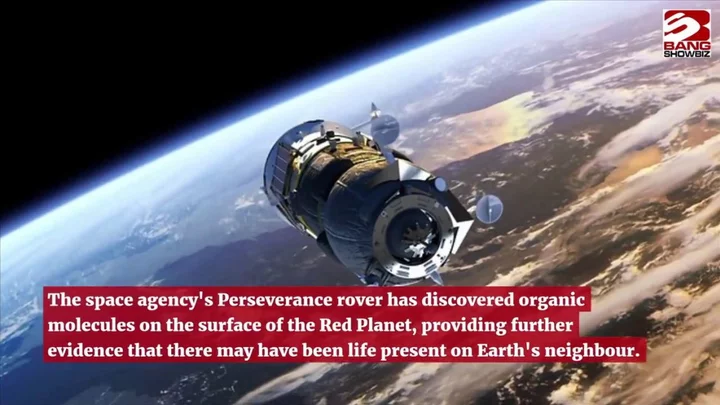
Nasa has found ‘diverse organic matter’ on surface of Mars
Nasa has discovered “diverse organic matter” on the surface of Mars, which could change our understanding of the red planet and the search for life in the universe. The Perseverance rover made the discovery in the Jezero Crater on Mars and a number of different explanations for the existence of the material have been posited. The materials could have been formed when water and dust interacted, or was dropped onto the planet by dust or meteors. Authors of the new study also refused to rule out that the materials are “biotic”, or came about due to the existence of life on the surface. Sign up to our free Indy100 weekly newsletter The findings could have a big impact on the continued search for alien life, with research into the organic matter on the surface telling us more about the existence of carbon sources on Mars. The Jezero crater has been explored by The Scanning Habitable Environments with Raman and Luminescence for Organics and Chemicals (Sherloc) instrument on the rover since February 2021. The crater is the site of an ancient lake basin and all 10 target sites explored within it came back with signs of organic molecules. Even if the materials are not biological in origin, research into them could be crucial in the search for alien life, according to the researchers. “Not all organics are biological in origin. Observing spatial relationships between minerals and organics is necessary when evaluating organic origins and potential biosignatures. Everything we know of life on Earth is limited to what is preserved in the rock-mineral record. On Earth, biosignatures are found in certain minerals and some minerals are better at preserving organics than others,” said Ashley E Murphy, a researcher at the Planetary Science Institute and co-author on the new paper. “Mars may have had a similar early geologic history to Earth so we use our knowledge of life as we know it on Earth for where to look for potential evidence of past life on Mars. Mapping organics allows for a better understanding of if the Martian carbon cycle is similar to or different from Earth, and the potential of Mars to host life.” Writing in the Nature journal, the authors said: “Our findings suggest there may be a diversity of aromatic molecules prevalent on the Martian surface, and these materials persist despite exposure to surface conditions. “These potential organic molecules are largely found within minerals linked to aqueous processes, indicating that these processes may have had a key role in organic synthesis, transport or preservation.” The findings are published in a new article, ‘Diverse organic-mineral associations in Jezero crater, Mars’, in Nature. Have your say in our news democracy. Click the upvote icon at the top of the page to help raise this article through the indy100 rankings.
2023-07-14 22:48
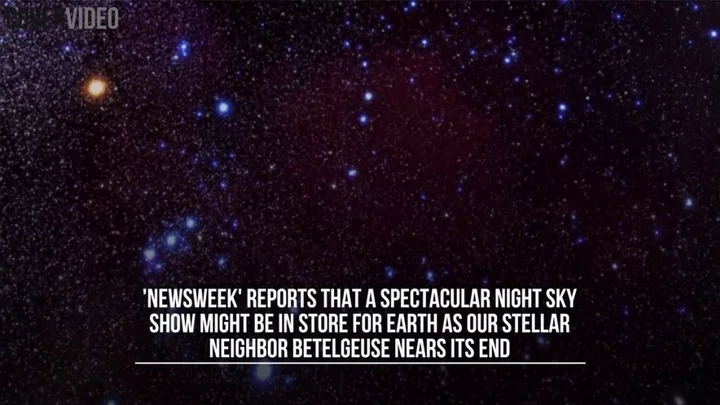
Scientists uncover supergiant ’space ghost’ in night sky
Scientists have been studying a “space ghost” which could be due to explode in just a few decades, changing the night sky forever – if it hasn’t already, that is. The object in question is a large star called Betelgeuse and the scientific community is divided over whether or not it’s already become a supernova. One theory states that the light from Betelgeuse takes so long to reach Earth it could mean the huge explosion has already taken place. Betelgeuse has been a supergiant red star for an estimated 40,000 years, but that could change relatively soon. Sign up to our free Indy100 weekly newsletter Michael Shara is the curator of astrophysics at the American Museum of Natural History. He told the US Sun: "Betelgeuse lies somewhere between about 450 and 550 light years from Earth." He went on to say: "Betelgeuse’s position appears to change slightly, as seen from Earth, between June and December, when the Earth is on opposite sides of its orbit around the Sun. "That tiny change in position is a direct measure of the distance to Betelgeuse." He went on to expand on the theory by saying: "Let's assume that Betelgeuse is precisely 500 light years distant. "If Betelgeuse exploded as a supernova anytime in the past 499 years, the light from that event has not yet had enough time to reach Earth…so we have no way of knowing if Betelgeuse has already blown up. "If, for example, Betelgeuse blew up in 1600 AD, we won’t know about it until the year 2100. But if it blew up on August 1, 1523, then on August 1, 2023 it will become about as bright as the full Moon. "The only naked eye supernova of the past century occurred in 1987… all astronomers would be thrilled and delighted if Betelgeuse (or another dying star) graced our night sky with a supernova in the coming decades." Have your say in our news democracy. Click the upvote icon at the top of the page to help raise this article through the indy100 rankings.
2023-07-14 20:26

Why trolling the likes of Andrew Tate is actually earning them money
Since Elon Musk’s takeover of Twitter, many controversial users who were previously banned from the platform have been allowed back on and are flourishing. Users such as Andrew Tate have regained a platform to spout his harmful views to millions of users. But, while it may feel satisfying to troll such users, engaging with their tweets actually earns them money. Here’s why: Twitter recently announced it was paying out thousands of dollars in advertising revenue to users to “benefit” from their high engagement on tweets, earning more money the higher their engagement is. As part of Twitter’s Ad Revenue sharing program, users require “5M+ Tweet impressions in each month for the last 3 months”. Sign up to our free Indy100 weekly newsletter On Thursday (13 July), some eligible users began receiving notifications of how much money they would receive. The highest earner, Dogecoin co-founder Billy Markus, known online as Shibetoshi Nakamoto, earned $37,050. Tate also revealed in a tweet that he earned $20,379 from ad revenue generated in the reply threads under his posts. The money comes from the ad revenue generated in their replies below the content they post on the platform, and is paid out via the Stripe account that the user registered for creator subscriptions with. Twitter staffer, Patrick Traughber, said: “Excited to start sending our first payments to creators for ads revenue sharing today. “Creators are the lifeblood of this platform, and it's great to see so many creators I follow getting paid today. The program will be expanding soon—more to come!” The cash payouts come just a week after Meta launched its rival text-based platform, Threads. Have your say in our news democracy. Click the upvote icon at the top of the page to help raise this article through the indy100 rankings.
2023-07-14 19:49
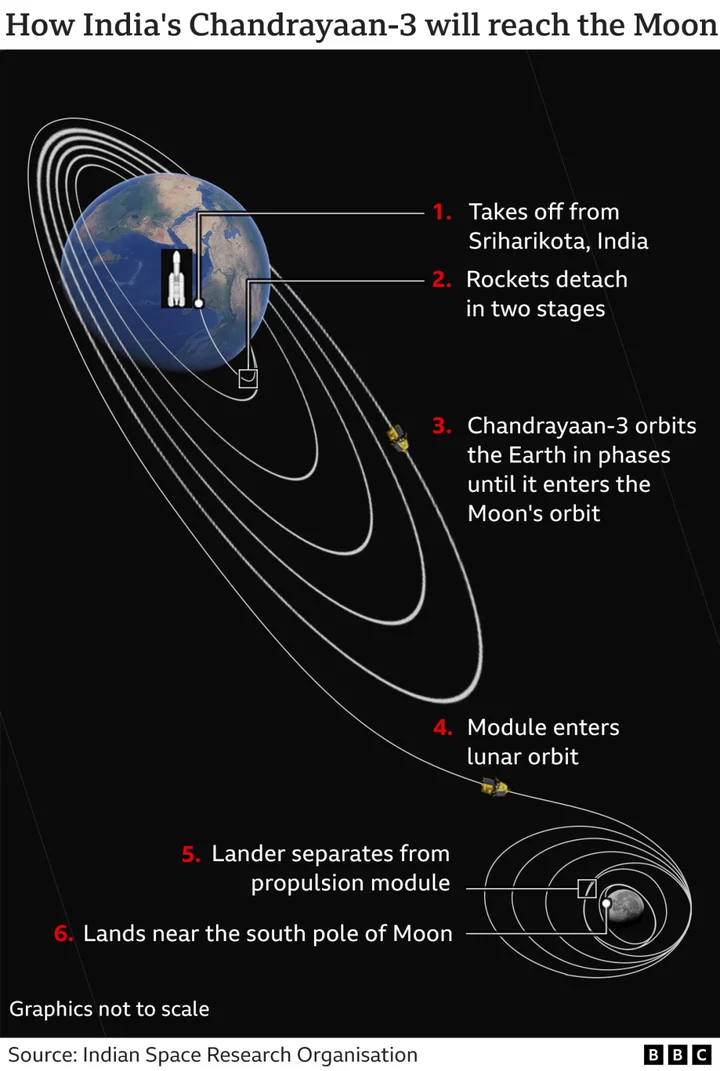
Chandrayaan-3: India's historic Moon mission lifts off successfully
With Chandrayaan-3, India aims to be the first to land near the Moon's little-explored south pole.
2023-07-14 17:51

Doctors reattach boy's head after suffering 'internal decapitation'
Doctors have performed a minor miracle after re-attaching a “'decapitated” boy’s head after he was hit by a car. The miraculous surgery occurred after Suleiman Hassan, a Palestinian boy from the West Bank, was severely injured after being hit by a car while out riding his bike. He was airlifted to Hadassah Ein Kerem’s Trauma Unit in Jerusalem and went straight to surgery. He suffered what is known as an internal decapitation – this occurs when the base of the skull and top of the spine become detached by the skin remains intact. This extremely rare injury can occur when a strong, sudden impact on the head results in the muscles and ligaments that hold the head in place to sever, accounting for less than one per cent of spinal injuries. Sign up to our free Indy100 weekly newsletter Doctors explained that Hassan’s head was “'almost completely detached from the base of his neck” before he underwent painstaking surgery taking several hours. The procedure involves reattaching the skull and spinal column using technology such as screws, rods, plates and bone grafts. One of the surgeons who operated on Hassan, Dr Ohad Einav, told The Times of Isreal: “We fought for the boy’s life.” Dr Einav continued: “The procedure itself is very complicated and took several hours. While in the operating room, we used new plates and fixations in the damaged area… “Our ability to save the child was thanks to our knowledge and the most innovative technology in the operating room.” Surgeries such as the one that saved Hassan’s life are only possible if internal decapitation victims have their major blood vessels intact, keeping the brain alive. Hassan’s surgery took place in June but has only recently been made public as the boy continues to recover at home with rehabilitation. Miraculously, Hassan can walk unaided and has no neurological problems following the shocking injury. Have your say in our news democracy. Click the upvote icon at the top of the page to help raise this article through the indy100 rankings.
2023-07-14 16:51
